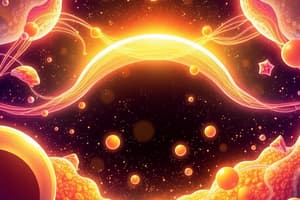Podcast
Questions and Answers
What defines organic compounds?
What defines organic compounds?
Which of the following is a characteristic of carbohydrates?
Which of the following is a characteristic of carbohydrates?
What type of carbohydrate is formed by two covalently bonded monosaccharides?
What type of carbohydrate is formed by two covalently bonded monosaccharides?
Which of the following is NOT a type of lipid?
Which of the following is NOT a type of lipid?
Signup and view all the answers
What is the primary function of phospholipids?
What is the primary function of phospholipids?
Signup and view all the answers
How do saturated fatty acids differ from unsaturated fatty acids?
How do saturated fatty acids differ from unsaturated fatty acids?
Signup and view all the answers
Which of the following statements about starch is true?
Which of the following statements about starch is true?
Signup and view all the answers
What characterizes a steroid?
What characterizes a steroid?
Signup and view all the answers
Which molecule is commonly produced by animals for storing excess sugars?
Which molecule is commonly produced by animals for storing excess sugars?
Signup and view all the answers
What is a primary function of waxes in organic compounds?
What is a primary function of waxes in organic compounds?
Signup and view all the answers
What are the building blocks of proteins?
What are the building blocks of proteins?
Signup and view all the answers
Which type of bond connects amino acids in a protein?
Which type of bond connects amino acids in a protein?
Signup and view all the answers
What role do enzymes play within proteins?
What role do enzymes play within proteins?
Signup and view all the answers
During which process are molecules built by removing water?
During which process are molecules built by removing water?
Signup and view all the answers
Which is NOT a function of proteins?
Which is NOT a function of proteins?
Signup and view all the answers
What are the two types of nucleic acids?
What are the two types of nucleic acids?
Signup and view all the answers
What determines the identity of an amino acid?
What determines the identity of an amino acid?
Signup and view all the answers
What is the role of hemoglobin in proteins?
What is the role of hemoglobin in proteins?
Signup and view all the answers
Which statement about carbon's atomic structure is true?
Which statement about carbon's atomic structure is true?
Signup and view all the answers
What type of molecules are formed by linking monomers together?
What type of molecules are formed by linking monomers together?
Signup and view all the answers
Study Notes
Organic Chemistry
- Organic chemistry studies organic compounds.
- All organic compounds contain carbon.
- Many organic compounds come from living things.
- Most compounds found in nature are organic.
Carbohydrates
- Carbohydrates contain carbon, hydrogen, and oxygen in a 1:2:1 ratio.
- Sugars and starches are carbohydrates.
- Living things use carbohydrates for energy and structural support.
Monosaccharides
- Simplest carbohydrates, also called simple sugars.
- Examples: glucose and fructose
Disaccharides
- Two monosaccharides bonded together.
- Examples: sucrose (glucose + fructose), lactose (glucose + galactose), maltose (glucose + glucose)
Polysaccharides
- Large polymers of linked monosaccharides.
- Examples: starch (wheat, rice, corn, potatoes), cellulose (plant structural support), glycogen (animal energy storage), and chitin.
Lipids
- Lipids include fats, oils, waxes, and steroids.
- Lipids generally contain carbon, hydrogen, and oxygen, but in different ratios compared to carbohydrates.
Fats
- Composed of glycerol and three fatty acids.
- Used for energy storage and insulation.
- Excess carbohydrates are converted to fats.
- Fatty acid structure determines fat characteristics.
- Approximately 30 fatty acids are in animals.
Other Lipids
- Phospholipids: key components of cell membranes, controlling movement in and out of cells.
- Steroids: composed of four linked carbon rings; examples include cholesterol and hormones.
- Waxes: composed of fatty acids and alcohols.
Proteins
- Proteins are organic compounds composed of carbon, hydrogen, oxygen, nitrogen, and sometimes sulfur.
- Essential for all living things (e.g., muscles, hair, skin).
- Proteins are polymers of amino acids.
Amino Acids
- Building blocks of proteins.
- Twenty different amino acids are used to make proteins.
- Amino acid structure (including the side group) defines the amino acid.
- Amino acids are linked together by peptide bonds.
Protein Functions
- Movement (e.g., actin and myosin in muscle fibers)
- Structure (e.g., collagen)
- Biochemical control (e.g., enzymes)
- Transport (e.g., hemoglobin)
- Storage (e.g., casein in milk)
- Regulation (e.g., hormones)
Nucleic Acids
- Large, complex molecules composed of carbon, hydrogen, oxygen, nitrogen, and phosphorus.
- DNA and RNA are examples.
- DNA (deoxyribonucleic acid) is the genetic material.
- RNA (ribonucleic acid) plays various cellular roles.
- Nucleic acids can be linear, branched, or cyclical.
- Monomers form polymers.
- Chemical reactions (dehydration synthesis, hydrolysis) build or break molecules.
Studying That Suits You
Use AI to generate personalized quizzes and flashcards to suit your learning preferences.
Related Documents
Description
This quiz covers essential concepts in organic chemistry, focusing on carbohydrates and lipids. Participants will learn about the structure, types, and functions of these organic compounds. Dive into the details of monosaccharides, disaccharides, and polysaccharides, as well as the role of lipids in living organisms.




